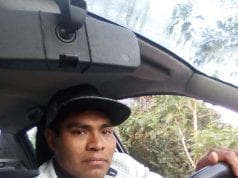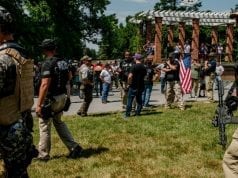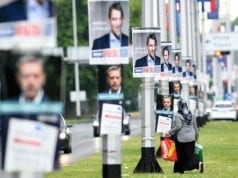
 The bodies of 15 people, including six children, were discovered at the site of a fierce overnight gun battle on the east coast of Sri Lanka, a military spokesman said on Saturday, six days after suicide bombers killed more than 250 people. The shootout between troops and suspected Islamist militants erupted on Friday evening in Sainthamaruthu in Ampara, to the south of the town of Batticaloa, site of one of the Easter Sunday blasts at three churches and four luxury hotels. A police spokesman said that three suspected suicide bombers were among the 15 dead after the shoot out. Military spokesman Sumith Atapattu said in a statement that as troops headed towards the safe house three explosions were triggered and gunfire began. “Troops retaliated and raided the safe house where a large cache of explosives had been stored,” he said in a statement. Sri Lankan police and army soldiers secure the site after the explosion and a gunbattle in Kalmunai, in eastern Sri Lanka Credit: Achala Upendra/AP He said the militants were suspected members of the National Thowheed Jama’at (NTJ), which has been blamed for last Sunday’s attacks. Mohamed Saleem, President of Jamiathul Ulema, a governing Muslim body, told the Telegraph: “The house had been rented out to two men from Kathankudy on the 16th of April. “It was rented out by two men who claimed that they were planning to start a business in the area. Four days after they rented the place, more than two people started moving in. The landlord and the neighbours became suspicious when a larger crowd moved in and they started moving boxes in and out of the house in a van. The landlord, mosque authorities and local residents then complained to the police, according to Mr Saleem. On Friday, four mosque officials, the village leader and the landlord visited and demanded to search the house where the terrorists were staying. The men initially refused saying there were women in the house, then pulled out a AK47 rifle and shot up in the air, trying to frighten them away. He then took stacks of money, all in 5,000 Rupee bundles, screaming at them to take it. As they landlord and others ran for cover there was another explosion and the military arrived and there was a shootout. Earlier, detectives had found explosives, drones and an Islamic State group banner and robes used in a propaganda video recorded before the bombers detonated in crowded hotels and restaurants. The bombers filmed themselves swearing allegiance to Islamic State in Iraq and Levant (Isil) before they killed 253 Christians, hotels guests and staff. The clashes on Friday came as the country remained on high alert and thousands of extra security forces had been drafted onto the streets. Sri Lankan authorities also said the extremist preacher suspected of masterminding and leading the bombings died in the blast at the Shangri La hotel, where British victims died. The interior of St Anthony’s Shrine five days after a series of bomb blasts targeting churches and luxury hotels on Easter Sunday Credit: AFP Mohamed Zahran, the leader of the local jihadi group National Thowheed Jamath, known for his incendiary speeches on social media, was one of the suicide bombers who carried out the attacks on three hotels and three churches, the police said on an official Twitter account. Detectives had also arrested the group’s second-in-command and said the militants’ military training was provided by “Army Mohideen” and weapons training had taken place overseas and at some locations in Sri Lanka’s Eastern province. Maithripala Sirisena, the president, said the group was driven by “religious fanaticism,” suggesting its leader had killed himself to “set an example” and gain more followers. However, Chula Senaviratne, the national security chief, said there was “still ambiguity whether he is dead or not” while DNA tests are being carried out. Members of the public join in an interfaith candlelight vigil during a Mass of Remembrance Credit: BIANCA DEMARCHI/REX “There is strong likelihood that the decapitated head of the suicide bomber at Shangri La was the same person we identified in the photographs…” he added. “However, we cannot be absolutely certain.” Sri Lankan officials have made claims and counterclaims in the chaotic aftermath of Sunday’s atrocities as security forces rush to detain suspects and the government reels from failures to act on warnings that bombings were imminent. Security agencies are also trying to track down hauls of explosives, some of which may have been left over from Sri Lanka’s decades-long civil war. President Sirisena told reporters in Colombo that some 140 people had been been identified as having links to the Islamic State group, although he reassured the public that the Sri Lankan government has “the capability to completely control ISIS activities”. The government has apologised for its failure to act on precise and repeated alerts from India that named suspects planning to attack local churches. Sri Lanka’s Catholic leader said he felt “betrayed” by the failure to act on warnings that could have prevented the bloodshed. Cardinal Malcolm Ranjith, Archbishop of Colombo, said he had asked for an explanation, but not received an answer. olice officers patrol the area around Dawatagaha Jumma Masjid ahead of Friday prayers Credit: Carl Court/Getty As fears of retaliation or follow-up attacks continued, Muslims were asked to stay at home to pray rather than attend Friday prayers in mosques that could also be targeted by extremists. The Sri Lankan authorities have confirmed that seven suicide bombers carried out the attacks, including Adbul Lathief Jameel Mohammed who studied engineering for a year in the UK. They said all the bombers came from a middle-class, educated background. In new details that emerged on Friday, the police said that the attackers had worked out at a local gym and by playing soccer using their authentic national identity cards. They added that the vehicles used in the attack were purchased from a car dealership in Kadawatha, a suburb of the capital. They said that the operator of a copper factory who was arrested in connection with the bombings had helped Mohideen make improvised explosive devices and purchase empty cartridges sold by the Sri Lankan military as scrap copper. Ranil Wickremesinghe, the prime minister, has said investigators are still working to determine the extent of the bombers’ foreign links.
The bodies of 15 people, including six children, were discovered at the site of a fierce overnight gun battle on the east coast of Sri Lanka, a military spokesman said on Saturday, six days after suicide bombers killed more than 250 people. The shootout between troops and suspected Islamist militants erupted on Friday evening in Sainthamaruthu in Ampara, to the south of the town of Batticaloa, site of one of the Easter Sunday blasts at three churches and four luxury hotels. A police spokesman said that three suspected suicide bombers were among the 15 dead after the shoot out. Military spokesman Sumith Atapattu said in a statement that as troops headed towards the safe house three explosions were triggered and gunfire began. “Troops retaliated and raided the safe house where a large cache of explosives had been stored,” he said in a statement. Sri Lankan police and army soldiers secure the site after the explosion and a gunbattle in Kalmunai, in eastern Sri Lanka Credit: Achala Upendra/AP He said the militants were suspected members of the National Thowheed Jama’at (NTJ), which has been blamed for last Sunday’s attacks. Mohamed Saleem, President of Jamiathul Ulema, a governing Muslim body, told the Telegraph: “The house had been rented out to two men from Kathankudy on the 16th of April. “It was rented out by two men who claimed that they were planning to start a business in the area. Four days after they rented the place, more than two people started moving in. The landlord and the neighbours became suspicious when a larger crowd moved in and they started moving boxes in and out of the house in a van. The landlord, mosque authorities and local residents then complained to the police, according to Mr Saleem. On Friday, four mosque officials, the village leader and the landlord visited and demanded to search the house where the terrorists were staying. The men initially refused saying there were women in the house, then pulled out a AK47 rifle and shot up in the air, trying to frighten them away. He then took stacks of money, all in 5,000 Rupee bundles, screaming at them to take it. As they landlord and others ran for cover there was another explosion and the military arrived and there was a shootout. Earlier, detectives had found explosives, drones and an Islamic State group banner and robes used in a propaganda video recorded before the bombers detonated in crowded hotels and restaurants. The bombers filmed themselves swearing allegiance to Islamic State in Iraq and Levant (Isil) before they killed 253 Christians, hotels guests and staff. The clashes on Friday came as the country remained on high alert and thousands of extra security forces had been drafted onto the streets. Sri Lankan authorities also said the extremist preacher suspected of masterminding and leading the bombings died in the blast at the Shangri La hotel, where British victims died. The interior of St Anthony’s Shrine five days after a series of bomb blasts targeting churches and luxury hotels on Easter Sunday Credit: AFP Mohamed Zahran, the leader of the local jihadi group National Thowheed Jamath, known for his incendiary speeches on social media, was one of the suicide bombers who carried out the attacks on three hotels and three churches, the police said on an official Twitter account. Detectives had also arrested the group’s second-in-command and said the militants’ military training was provided by “Army Mohideen” and weapons training had taken place overseas and at some locations in Sri Lanka’s Eastern province. Maithripala Sirisena, the president, said the group was driven by “religious fanaticism,” suggesting its leader had killed himself to “set an example” and gain more followers. However, Chula Senaviratne, the national security chief, said there was “still ambiguity whether he is dead or not” while DNA tests are being carried out. Members of the public join in an interfaith candlelight vigil during a Mass of Remembrance Credit: BIANCA DEMARCHI/REX “There is strong likelihood that the decapitated head of the suicide bomber at Shangri La was the same person we identified in the photographs…” he added. “However, we cannot be absolutely certain.” Sri Lankan officials have made claims and counterclaims in the chaotic aftermath of Sunday’s atrocities as security forces rush to detain suspects and the government reels from failures to act on warnings that bombings were imminent. Security agencies are also trying to track down hauls of explosives, some of which may have been left over from Sri Lanka’s decades-long civil war. President Sirisena told reporters in Colombo that some 140 people had been been identified as having links to the Islamic State group, although he reassured the public that the Sri Lankan government has “the capability to completely control ISIS activities”. The government has apologised for its failure to act on precise and repeated alerts from India that named suspects planning to attack local churches. Sri Lanka’s Catholic leader said he felt “betrayed” by the failure to act on warnings that could have prevented the bloodshed. Cardinal Malcolm Ranjith, Archbishop of Colombo, said he had asked for an explanation, but not received an answer. olice officers patrol the area around Dawatagaha Jumma Masjid ahead of Friday prayers Credit: Carl Court/Getty As fears of retaliation or follow-up attacks continued, Muslims were asked to stay at home to pray rather than attend Friday prayers in mosques that could also be targeted by extremists. The Sri Lankan authorities have confirmed that seven suicide bombers carried out the attacks, including Adbul Lathief Jameel Mohammed who studied engineering for a year in the UK. They said all the bombers came from a middle-class, educated background. In new details that emerged on Friday, the police said that the attackers had worked out at a local gym and by playing soccer using their authentic national identity cards. They added that the vehicles used in the attack were purchased from a car dealership in Kadawatha, a suburb of the capital. They said that the operator of a copper factory who was arrested in connection with the bombings had helped Mohideen make improvised explosive devices and purchase empty cartridges sold by the Sri Lankan military as scrap copper. Ranil Wickremesinghe, the prime minister, has said investigators are still working to determine the extent of the bombers’ foreign links.








